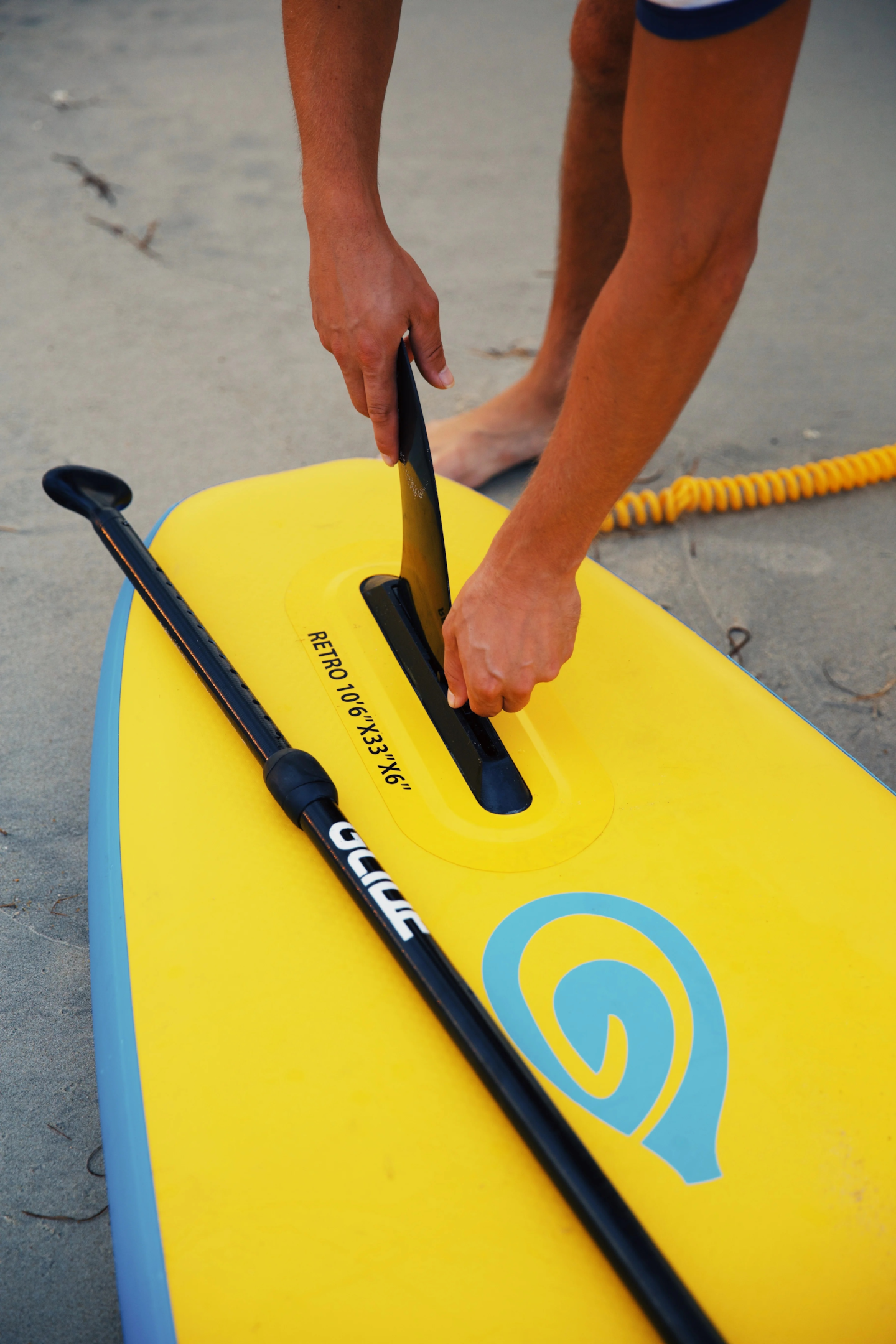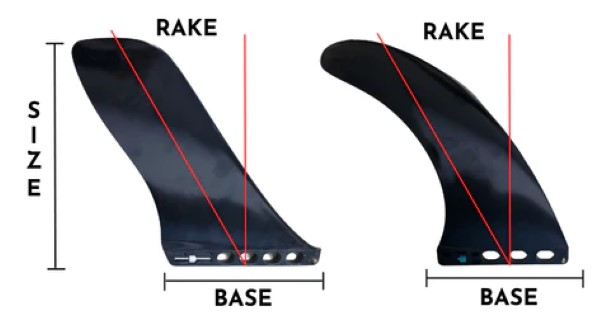
Are Paddle Board Fins Universal? Compatibility Guide
Not all paddle board fins fit all boards. Here’s how fin types and fin boxes work together—and why a US-style fin box gives you the most flexibility.
Paddle board fins aren’t universal because fin boxes aren’t universal.
Choose a board with a US-style fin box, then tailor fin shape, size, and material to your waters—dolphin for all-round, touring for distance, keel for shallow.
A couple of smart fin choices can transform stability, tracking, and turn control.
Table of contents
 Fin types 101 (and what they’re good for) The fin box is the gatekeeper (and why US box wins) Matching fin + box + conditions Sizing essentials: height, base, rake, area Materials matter (and why) Common compatibility questions Tuning tips to feel the difference today What to buy (quick checklist) When to ask an expert Final Thoughts Are Paddle Board Fins Universal? FAQs
Fin types 101 (and what they’re good for) The fin box is the gatekeeper (and why US box wins) Matching fin + box + conditions Sizing essentials: height, base, rake, area Materials matter (and why) Common compatibility questions Tuning tips to feel the difference today What to buy (quick checklist) When to ask an expert Final Thoughts Are Paddle Board Fins Universal? FAQs
The short answer
No—paddle board fins are not universal. A fin’s ability to fit (and perform) depends on three things working together:
-
the fin type, 2) your board’s fin box system, and 3) your intended conditions (flatwater, touring, surf, shallow).
Getting those right unlocks better tracking, stability, and maneuverability—plus easier replacements and upgrades.
Fin types 101 (and what they’re good for)
-
Dolphin (rake) fin: The all-rounder. Moderate base and rake; good tracking with easy enough turning for flatwater, light touring, and casual surf.
-
Pivot fin: Tall, large base, minimal rake. Tracks straight and feels very stable—great on touring and race boards. Not as nimble for quick turns unless you’re doing pivot turns.
-
Keel (shallow) fin: Short height, long base, big rake. Stays clear in shallow water, weed beds, and rocky launches; sacrifices tight turning.
-
Side bites (thruster/2+1 setups): Add bite in surf or river settings; increase hold and responsiveness on hard turns.
-
River/low-profile fins: Shorter, snag-resistant profiles for shallow, technical river runs.
The fin box is the gatekeeper (and why US box wins)
Your fin box determines which fins can physically mount to your board:
-
US-style fin box (most recommended):
The industry workhorse with a center track and screw/plate. It supports the widest variety of aftermarket fins—touring, dolphin, river, keel—and lets you slide the fin forward/back to tune handling. Replacements are easy to find. -
Click-in / proprietary boxes:
Fast and convenient, but you’re often limited to that brand’s ecosystem. Great for simplicity, not as great for long-term flexibility or specialty fin shapes. -
FCS/Futures (surf standards):
Common on surf craft and some SUP surf boards for side fins. Excellent variety for surf performance, but not the typical system for a center touring fin on flatwater boards.
Takeaway: If you want choice, tuning range, and easy replacements, pick a board with a US-style fin box.
Matching fin + box + conditions
-
Flatwater & fitness: Start with a dolphin fin in a US box. Slide aft for more tracking on long stretches; slide forward for easier turns in tight spots.
-
Touring & race: A pivot/touring fin in a US box helps the board hold a line and reduces the need for corrective strokes—more efficiency over distance.
-
Shallow rivers & weed beds: A keel or river fin in a US box prevents hang-ups; consider flexible materials for bump forgiveness.
-
Surf & beach breaks: A 2+1 or thruster setup (center + side bites) adds hold on the face and stability through turns.
-

Sizing essentials: height, base, rake, area
-
Height: More height = better tracking, but watch depth in shallow spots.
-
Base length: Longer base = stronger tracking and stability, slower pivoting.
-
Rake (sweep): More rake = smoother tracking and fewer weeds caught; less rake = snappier pivot turns.
-
Area: More surface area = more hold and stability; smaller = looser feel and easier maneuvering.
Materials matter (and why)
-
Plastic/nylon: Affordable, durable, slightly flexy—good general purpose.
-
Glass/nylon blends: A touch stiffer for crisper response.
-
Fiberglass/carbon: Light and stiff for performance; sharper, more defined feedback.
-
Rubber/flex fins: Great for shallow/river use where strikes are likely.
Common compatibility questions
-
“Will any fin fit my inflatable SUP?”
Only if your inflatable uses a US box. Many do, but some use proprietary click-in systems. Check your box first. -
“Can I use surf FCS side fins on my center box?”
No. Surf plugs (FCS/Futures) are not compatible with US center boxes. They’re different systems for different fin roles. -
“Can I upgrade the fin box?”
On hard boards, a skilled repair tech can replace a box. On inflatables, you’d need brand-specific parts and a pro install—often not worth it versus choosing a board that already has a US box.
Tuning tips to feel the difference today
-
Slide the fin back for straighter tracking on long paddles.
-
Slide the fin forward for quicker turns in marinas, twisty creeks, or with kids/dogs on the nose.
-
Go shorter (or flexible) for shallow rivers to avoid sudden stops and fin damage.
-
Try a touring fin before a race or a long tour—many paddlers gain speed simply by reducing corrective strokes.
-
Swap materials to change feel: plastic (softer) → fiberglass/carbon (crisper).
What to buy (quick checklist)
-
Board with a US-style fin box for maximum choice.
-
One good all-round dolphin fin for everyday paddling.
-
One specialty fin matched to your main need (touring pivot fin or shallow/river fin).
-
Spare screw/plate in your kit—cheap insurance.
-
Small tool or coin to tighten hardware on the beach.
When to ask an expert
-
You’re unsure which fin pairs best with your board width, length, and use case.
-
You’re changing disciplines (e.g., flatwater → touring, or lakes → rivers).
-
Your board uses a proprietary fin system and you want the closest-match upgrade.

Final Thoughts Are Paddle Board Fins Universal?
Are paddle board fins universal? No—and that’s actually good news. Once you understand how fin type + fin box + conditions interact, you can fine-tune how your board tracks, turns, and feels underfoot. If you value flexibility and easy upgrades, start with a US-style fin box and keep a small quiver: an all-round dolphin fin for most days, plus a purpose-built fin for your favorite conditions. Small part, big payoff.
FAQs
Are US-box fins compatible across brands?
Yes. The US-style center box is a common standard. Any US-box compatible center fin (with the right screw/plate) should fit.
Do I need different fins for inflatable vs. hard boards?
Not inherently—fins are chosen for conditions and handling. What matters is the fin box system. Many inflatables use US boxes now, which makes sharing fins easy.
What fin should I use for long distances?
A touring/pivot fin with more height and base gives stronger tracking and fewer corrective strokes—great for efficiency.
How do I avoid snagging in shallow water?
Use a keel/river fin with shorter height and generous rake, or a flexible fin to reduce hang-ups and damage.
Why does my board feel “twitchy” with a small fin?
Less area and height reduce hold and tracking. Swap to a slightly larger fin or slide the fin farther back in the box.





